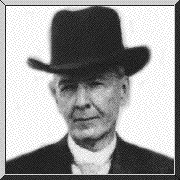 Luther
Burbank, was
born on March 7, 1849 in Lancaster, Massachusetts. Burbank was the
thirteenth of fifteen children in his family. He was educated at the
Lancaster Academy in Massachusetts, where he received the equivalent
of a high school education. He began breeding plants and conducting
genetics research in 1870. In 1871 he produced the Burbank potato
which was a blight resistant species used in Ireland to combat the
potato epidemic which had effected that nation's potato crops and
which had results in the emigration of half of that nation's people.
With the money he gained by selling his rights to the potato, he
moved to Santa Rosa, California.
Luther
Burbank, was
born on March 7, 1849 in Lancaster, Massachusetts. Burbank was the
thirteenth of fifteen children in his family. He was educated at the
Lancaster Academy in Massachusetts, where he received the equivalent
of a high school education. He began breeding plants and conducting
genetics research in 1870. In 1871 he produced the Burbank potato
which was a blight resistant species used in Ireland to combat the
potato epidemic which had effected that nation's potato crops and
which had results in the emigration of half of that nation's people.
With the money he gained by selling his rights to the potato, he
moved to Santa Rosa, California.
Burbank held the belief that inheritance was determined by acquired characteristics, which support Lamarch's theory of genetic variation. The works of Gregor Mendel were unknown to Burbank in his early career. Burbank's work focused on hybridization and grafting of plant tissues from one plant to another. Burbank's research focused on making multiple crosses between native plants and introduced new strains of existing plants. Later in his career, Burbank lectured on evolution at Stanford University.
During his years in Santa Rosa, Burbank developed more than sixty varieties of plums and ten new commercial varieties of berries. He also developed new species of pineapples, walnuts, and almonds. While truck crops were Burbank's primary interest, he also worked at developing new flowering plants. Burbank is given credit for developing the Fire poppy, Ostrichplume clematis, Shasta daisy, Burbank rose, new varieties of lilies and ornamental shrubs. Luther Burbank's discoveries of new varieties of plants were based on careful and time consuming experiments. His development of the white blackberry required 65,000 unsuccessful crosses before he obtained the desired result. Burbank died in 1926 at the age of 77.
References
Asimov, I. (1964). Asimov's Biographical Encyclopedia of Science and Technology: The Living Stories of More than 1000 Great Scientists from the Age of Greece to the Space Age Chronologically Arranged. Garden City, NY: Doubleday.
Howard, A.V. (1951). Chamber's Dictionary of Scientists. London: Chambers.
Pearson, W., & Bechtel, H.K. (1989). Blacks, Science, and American Education. New Brunswick, NJ: Rutgers University Press.
Sammons, V.O. (1990). Blacks in Science and Medicine. New York: Hemisphere.